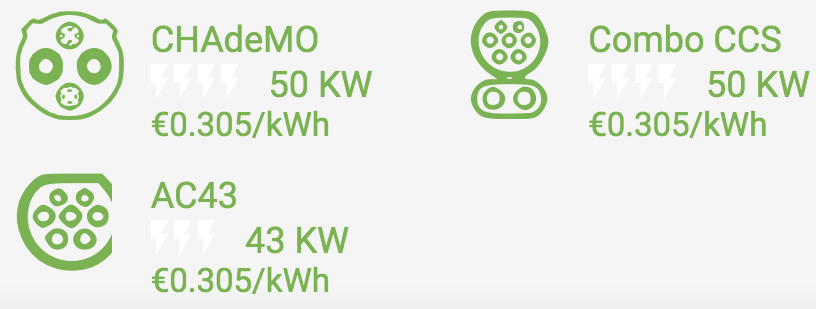Charging Connector
Charging Connectors 🔌
There are a number of charging connectors
The options for different types of connectors are as follows:
- AC or DC
- Single or three phase (for AC)
- Speed of charge
- Extra control pins
The ESB in Ireland support three different types of connectors:
- DC CHADEMO: (Nissan Leaf, Mitsubishi)
- CCS COMBO: (BMW, Volkswagen, Hyundai)
- AC 43: (Renault Zoe)
- Some also support Type 2 connectors

CHAdeMO
DC chargers can usually deliver more power than AC chargers. This is because an onboard rectifier is not needed for DC charging because the rectifier is in the charging station itself.
Power: 400kW (DC)
Voltage: Max 500V
Current Max 125A
Communication: CAN
CCS Combo
“The CCS combines single-phase with rapid three-phase charging using alternating current at a maximum of 43 kilowatts (kW), as well as direct-current charging at a maximum of 200 kW and the future perspective of up to 350 kW – all in a single system.” - taken from the CCS combo specification 1.0 at: spec 1.0.
Charging modes:
Mode 1:
- AC charging at normal mains outlets
- No protection devices in the charging cable
- RCD in domestic installations an essential prerequisite
- No energy feedback, no communications
Mode 2:
- AC charging at normal mains outlets
- Charger cable with integrated safety devices in an in-cable control box comprising RCD, control pilot and proximity sensor
- Without energy feedback, signaling between the in-cable control box and the electric vehicle is possible via the control pilot
Mode 3:
- AC charging at Type 1/2 charging stations
- Safety equipment is a permanent part of the charging station, no in-cable control box required in the cable
- Type 2 plug interlock permits unsupervised operation, even in a public space
- As opposed to modes 1 and 2, energy feedback is possible via HLC, since communications are bidirectional throughout, control is possible and plugs can be locked
Mode 4:
- DC charging at Combo 1/2 charging stations
- Charging system can manage various charging currents and charging voltages to adopt various battery systems
- For charging control HLC is required
- The charging station acts as an off-board charger
Power: Max 43kW (AC) / Max 350kW (DC)
Voltage: Max 500V
Current Max 125A
Communication: PWM / PLC
